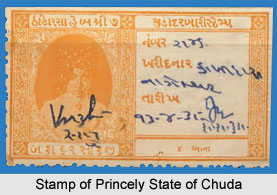 The Princely State of Chuda was one of the former native states during the rule of the British Empire in India. During the early 19th century, the region was appointed as one of the princely states of India under the indirect rule of the British administration. The region was scattered over a total area of 78.2 sq miles and is a part of the Indian state of Gujarat. The region comprised of a total population of 15,818 in the year 1941. The state of Chuda was situated in northeastern Kathiawar and the territory consisted of around 14 villages. The princely state of Chuda was bounded by the princely state of Wadhwan in the north; by the princely state of Limbdi and the talukas of Bhoika Thana in the east; by the talukas of Paliad Thana in the south; and by the princely state of Sayla and Paliad Thana in the west.
The Princely State of Chuda was one of the former native states during the rule of the British Empire in India. During the early 19th century, the region was appointed as one of the princely states of India under the indirect rule of the British administration. The region was scattered over a total area of 78.2 sq miles and is a part of the Indian state of Gujarat. The region comprised of a total population of 15,818 in the year 1941. The state of Chuda was situated in northeastern Kathiawar and the territory consisted of around 14 villages. The princely state of Chuda was bounded by the princely state of Wadhwan in the north; by the princely state of Limbdi and the talukas of Bhoika Thana in the east; by the talukas of Paliad Thana in the south; and by the princely state of Sayla and Paliad Thana in the west.
The erstwhile princely state of Chuda was under the administrative control of the Baroda Agency, which was incorporated as a part of the Western India States Agency. Later the territory was merged with the state of Gujarat. The state was also a included as a part of the Eastern Kathiawar Agency.
History of Princely State of Chuda
The Jhala Rajputs, who were descendants of the rulers of Wadhwan state, were the ruling family of the state of Chuda. The brother of Arjun Singh of Wadhwan and Zelim Singh of Kotah, Abhaya Singh, established his authority in the territory of Chuda during the years 1706 and 1707. His son and grandson, who succeeded him on the gadi, died fighting the Kathis of Paliad. After the involvement of the state in the civil war of Jhala during the culmination of the century, the princely state of Chuda was reduced to despair. The succession of the throne or gadi of the state was governed by the rule of male primogeniture, by which the first born or eldest child of the same parents the first born or eldest child of the same parents, to the exclusion of all others. There was also the practice of bestowed large hereditary landed states to younger sons had caused Chuda state to decrease down to a sovereignty of 14 villages.
The native ruler of the princely state of Chuda, who held the title of Thakor Saheb, exercised considerable civil and criminal jurisdictional authority. The native state was ranked 22nd amongst the states of Western India. Before the abolition of the class system in the year 1925, the state belonged to the Third Class of Kathiawari states. The princely state of Chuda paid annual tribute to the princely state of Junagadh. Chuda state was one of the original constituent members of the Chamber of Princes, a number of smaller states indirectly represented by 12 princes who were elected periodically by them.
According to the Attachment Scheme of 1943, the princely state of Chuda was attached to the princely state of Dhrangadhra. It was one of the 15 states in the second phase that refused initially to cooperate with the attaching of princely states.
After the withdrawal of the British administration and the partition of India on 15th August 1947, the princely state was acceded to the newly formed Union of India, which was also known as the Dominion of India.
Rulers of Princely State of Chuda
The chronology of the native rulers, known as Thakor Saheb of the princely state of Chuda, is discussed as follows-
* Thakore Shri Abhaisinhji Madhavsinhji (1707- 1747)
* Thakore Shri Raisinhji Abhaisinhji (1747- 1768)
* Thakore Shri Gajsinhji Raisinhji (1768- 1780)
* Thakore Shri Hathisinhji Gajsinhji (1780- 1820)
* Thakore Shri Abhaisinhji Hathisinhji (1820- 1830)
* Thakore Shri Raisinhji Abhaisinhji (1830- 1854)
* Thakore Shri Becharsinhji Raisinhji (1854- 1908)
* Thakore Shri Jorawarsinhji Madhavsinhji (1908- 1920)
* Thakore Shri Bahadursinghji Jorawarsinghji (1920- 1947)
* Thakore Shri Dharmendrasinhji Bahadursinhji
* Thakore Shri Krishnakumarsinhji Dharmendrasinhji



















